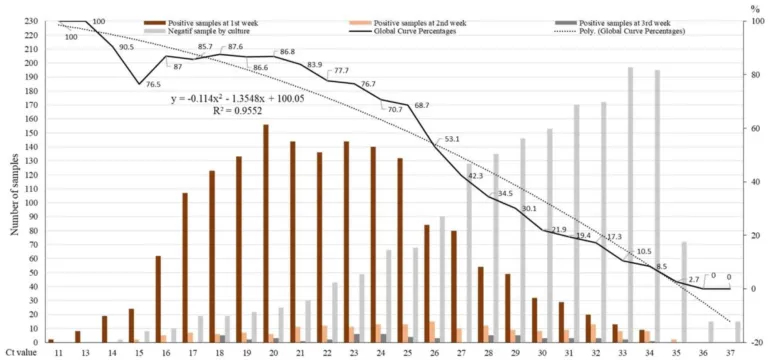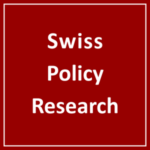The Failure of PCR Mass Testing
DEBATES ON COVID - VACCINES, 21 Jun 2021
Swiss Policy Research - TRANSCEND Media Service
A new German study confirms and explains the failure of PCR mass testing.

PCR cycle threshold (11-37) and positive cell culture (black line, 100% to 0%). The colored bars indicate the number of positive cell cultures per ct per week after infection (1 to 3 weeks). (Jafaar/Raoult)
19 Jun 2021 – Since March 2020, SPR has warned that PCR mass testing in the general population (“test, test, test”) is a huge mistake. The issue never was that PCR tests didn’t work or that the Drosten PCR paper was “peer-reviewed” in just one day. The issue is that PCR tests cannot determine an acute infection, ongoing infectiousness, and actual disease, especially if ct values are not taken into account.
Several studies have since shown that national PCR testing rates have had no influence at all on covid mortality. In addition, a new German study re-analyzed PCR tests of 160,000 people and concluded:
“In light of our findings that more than half of individuals with positive PCR test results are unlikely to have been infectious, RT-PCR test positivity should not be taken as an accurate measure of infectious SARS-CoV-2 incidence. Our results confirm the findings of others that the routine use of ‘positive’ RT-PCR test results as the gold standard for assessing and controlling infectiousness fails to reflect the fact ‘that 50-75% of the time an individual is PCR positive, they are likely to be post-infectious.’” (Stang et al, Journal of Infection, May 2021)
Why has mass PCR testing failed so badly? Most likely because of the role of pre-symptomatic transmission: by the time someone gets a ‘positive’ test result, the infectious virus is already being neutralized, or in some cases is already long gone. Hence PCR testing really only makes sense in targeted, preemptive high-risk settings, such as hospitals, nursing homes or early border controls, or possibly in Chinese-style preemptive, pooled mass testings of entire 10-million-people cities.
Overall, PCR mass testing has achieved essentially nothing but hundreds of billions in unnecessary costs and large-scale psychological trauma, especially in children. Nevertheless, with millions of deaths, covid was not just a “casedemic” or a “fake pandemic” (as the 2009 swine flu), but a PCR-driven “casedemic” on top of a real pandemic – or in other words: a “strange pandemic”.
____________________________________________
Related: The trouble with PCR tests (October 2020)
See also:
__________________________________________
 Swiss Policy Research, founded in 2016, is an independent, nonpartisan and nonprofit research group investigating geopolitical propaganda in Swiss and international media. SPR is composed of independent academics that for personal and professional reasons prefer to protect their identities, and receives no external funding; there are no financial sponsors or backers. Our articles have been published or shared by numerous independent media outlets and journalists, among them Julian Assange, and have been translated into more than two dozen languages.
Swiss Policy Research, founded in 2016, is an independent, nonpartisan and nonprofit research group investigating geopolitical propaganda in Swiss and international media. SPR is composed of independent academics that for personal and professional reasons prefer to protect their identities, and receives no external funding; there are no financial sponsors or backers. Our articles have been published or shared by numerous independent media outlets and journalists, among them Julian Assange, and have been translated into more than two dozen languages.
Tags: COVID-19, Conspiracy Theories, Coronavirus, Economy, Elites, Environment, Health, Lockdown, New World Order, Pandemic, Public Health, Research, Robert F. Kennedy Jr, Science and Medicine, Vaccines, WHO, World
DISCLAIMER: The statements, views and opinions expressed in pieces republished here are solely those of the authors and do not necessarily represent those of TMS. In accordance with title 17 U.S.C. section 107, this material is distributed without profit to those who have expressed a prior interest in receiving the included information for research and educational purposes. TMS has no affiliation whatsoever with the originator of this article nor is TMS endorsed or sponsored by the originator. “GO TO ORIGINAL” links are provided as a convenience to our readers and allow for verification of authenticity. However, as originating pages are often updated by their originating host sites, the versions posted may not match the versions our readers view when clicking the “GO TO ORIGINAL” links. This site contains copyrighted material the use of which has not always been specifically authorized by the copyright owner. We are making such material available in our efforts to advance understanding of environmental, political, human rights, economic, democracy, scientific, and social justice issues, etc. We believe this constitutes a ‘fair use’ of any such copyrighted material as provided for in section 107 of the US Copyright Law. In accordance with Title 17 U.S.C. Section 107, the material on this site is distributed without profit to those who have expressed a prior interest in receiving the included information for research and educational purposes. For more information go to: http://www.law.cornell.edu/uscode/17/107.shtml. If you wish to use copyrighted material from this site for purposes of your own that go beyond ‘fair use’, you must obtain permission from the copyright owner.
Read more
Click here to go to the current weekly digest or pick another article:
DEBATES ON COVID - VACCINES: